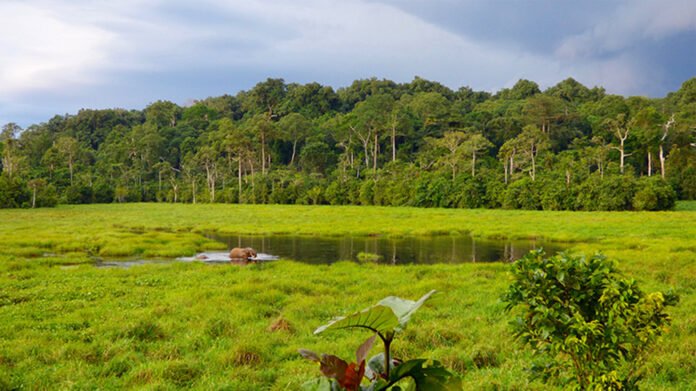This piece comes to us from the Wildlife Conservation Society (WCS).
For over 50 years, we have set aside April 22 as a day to celebrate our planet. It’s a time for many to get outside to our beautiful parks and hike our natural places. It’s an occasion to tend to gardens that will soon be bursting with flowering plants and vegetables. But if Earth Day is an opportunity to appreciate the natural world, it is also a moment to take stock of threats it faces and what we can do to protect it.
For those of us in the conservation community, that often comes in the form of officially designated “protected areas” designed to the ensure sustainable use of natural resources in a manner that protects species richness and habitat while ensuring that resident Indigenous Peoples and local communities can continue to occupy and secure their traditional territories while benefiting from new livelihood opportunities.

African forest elephant at Mbeli Bai, Nouabalé-Ndoki National Park, Republic of Congo. Photo credit: Diane Detoeuf/ WCS.
In an increasingly interconnected world, the United States’ commitment to the protection of nature across the globe is not merely an act of altruism but a strategic imperative that safeguards national security and promotes economic prosperity. Grounded in the principles of natural security, this commitment also addresses the intricate linkages between environmental conservation and geopolitical stability.
The concept of natural security holds that the degradation of nature—such as deforestation, wildlife trafficking, and water scarcity—can lead to significant threats, including social unrest, economic downturns, and heightened vulnerability to natural disasters. For instance, the illegal wildlife trade generates billions of dollars annually, financing criminal syndicates and extremist groups that threaten U.S. security interests and undermine the rule of law.
By investing in protected areas, the U.S. has sought to address these threats at their source, promoting peace in regions critical to our strategic priorities. Unfortunately, in far too many cases, these areas end up as “paper parks,” where a government has committed to an area’s protection without the resources to do the job effectively. Local communities based near or in these parks likewise lack the resources to support the park.

Yellow Cheeked Gibbon (Nomascus gabriellae), Keo Seima Wildlife Sanctuary, Cambodia. Photo credit: Adam Roberts/ WCS Cambodia.
In 2024, to address that challenge while recognizing the importance of conservation, Congress passed the U.S. Foundation for International Conservation Act. This bipartisan legislation established a groundbreaking public-private partnership to support global conservation and economic development, authorizing up to $100 million in federal funding annually, matched 2:1 by non-U.S. government funding.
The foundation aims to protect endangered wildlife, support conservation efforts worldwide, and, by extension, enhance global stability while combating illicit activities that threaten U.S. interests. The nonpartisan nature of international conservation funding is exemplified by the collaborative efforts of U.S. Senators Lindsey Graham (R-SC) and Chris Coons (D-DE) in championing the bill, which was enacted in December 2024.
Senator Graham highlights the strategic advantages provided by conservation efforts when he notes, “The U.S. Foundation for International Conservation is a win-win in that the bill leverages private capital while supporting the long-term protection of critical landscapes around the world. Investments in conservation lead to food security and regional stability.”
Sen. Graham’s comment underscores the recognition across party lines that international conservation funding is integral to U.S. national security and global leadership. By maintaining and enhancing such assistance we strategically position our nation to address global challenges that have direct implications for domestic stability and prosperity. Marco Rubio’s support for the law during his confirmation hearings to become U.S. Secretary of State affirms that idea.

Madidi National Park, Bolivia. Photo credit: WCS Bolivia.
As intact areas with ecological integrity—that is, areas with a full array of species in very healthy numbers and with its ecosystem functioning as it should—become degraded, they are denuded of their trees. Fish and wildlife are no longer abundant. For local people, these areas become unlivable, and you start to see increased pressure on out-migration, creating more pressure on neighboring countries.
That creates conditions of instability that gives rise to rebel groups and crippling insurgencies, as you find in Central Africa and parts of Latin America today. The establishment of the US Foundation for International Conservation reinforces the nation’s longstanding commitment to conservation as a means of securing a safer, healthier planet and demonstrating by example the power of democratic governance and American values.
It also enables us to benefit from the innumerable services that nature provides for people across the globe—from wetlands buffering the impacts of storms of growing intensity to the multitude of medicines derived from nature. To take just one example, the chemical vinblastine, found in Madagascar’s rosy periwinkle plant, has been critical to the treatment of lymphomas and testicular, breast, bladder, and lung cancers.
When grounded in the principles of natural security, conservation addresses the complex interplay between environmental conservation and geopolitical stability. Moreover, as a public-private partnership, it does so without the entire burden falling on American taxpayers.
This Earth Day, as we take a pause to take in the beauty of nature with a short walk in, or drive from, our respective cities, towns, suburbs, and rural areas, let’s save a thought for the expansive and as-yet unsullied landscapes and marine areas whose protection contributes to the peace and security of countless regions across the planet that provide us with so many blessings.






